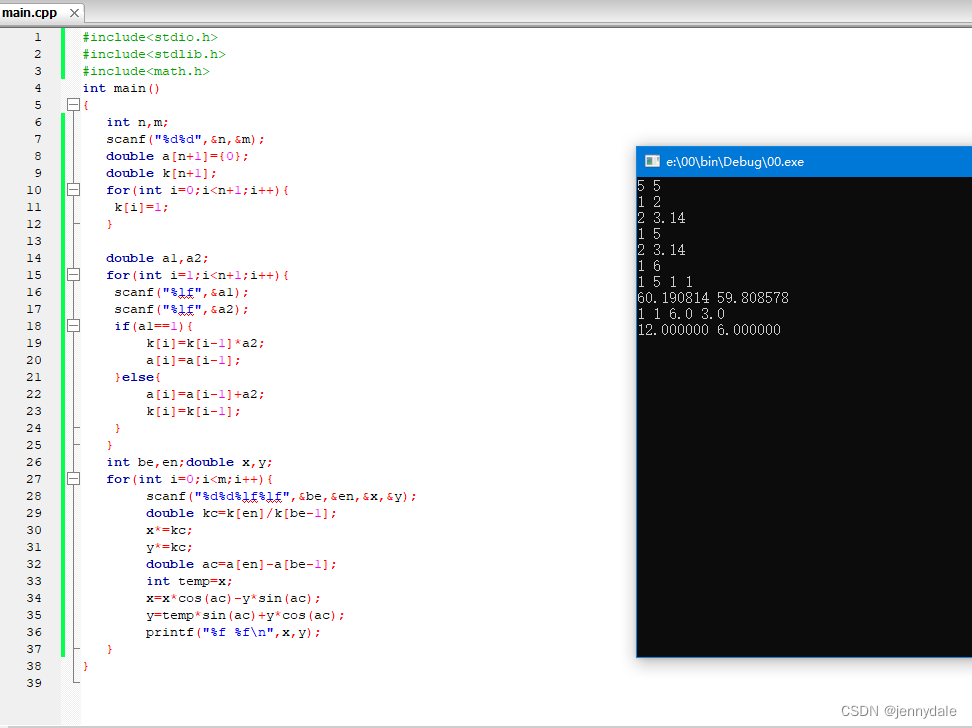C. Colorful Table
time limit per test
1 second
memory limit per test
256 megabytes
input
standard input
output
standard output
You are given two integers n� and k�. You are also given an array of integers a1,a2,…,an�1,�2,…,�� of size n�. It is known that for all 1≤i≤n1≤�≤�, 1≤ai≤k1≤��≤�.
Define a two-dimensional array b� of size n×n�×� as follows: bi,j=min(ai,aj)��,�=min(��,��). Represent array b� as a square, where the upper left cell is b1,1�1,1, rows are numbered from top to bottom from 11 to n�, and columns are numbered from left to right from 11 to n�. Let the color of a cell be the number written in it (for a cell with coordinates (i,j)(�,�), this is bi,j��,�).
For each color from 11 to k�, find the smallest rectangle in the array b� containing all cells of this color. Output the sum of width and height of this rectangle.
Input
The first line contains a single integer t� (1≤t≤1041≤�≤104) — the number of test cases. Then follows the description of the test cases.
The first line of each test case contains two integers n� and k� (1≤n,k≤1051≤�,�≤105) — the size of array a� and the number of colors.
The second line of each test case contains n� integers a1,a2,…,an�1,�2,…,�� (1≤ai≤k1≤��≤�) — the array a�.
It is guaranteed that the sum of the values of n� and k� over all test cases does not exceed 105105.
Output
For each test case, output k� numbers: the sums of width and height of the smallest rectangle containing all cells of a color, for each color from 11 to k�.
Example
input
Copy
5
2 1
1 1
2 2
1 2
3 5
3 2 4
4 2
1 2 1 2
5 3
1 2 3 2 1
output
Copy
4 4 2 0 6 6 2 0 8 6 10 6 2
Note
In the first test case, the entire array b� consists of color 11, so the smallest rectangle for color 11 has a size of 2×22×2, and the sum of its sides is 44.
In the second test case, the array b� looks like this:
| 1 | 1 |
| 1 | 2 |
One of the corner cells has color 22, and the other three cells have color 11. Therefore, the smallest rectangle for color 11 has a size of 2×22×2, and for color 22 it is 1×11×1.
In the last test case, the array b� looks like this:
| 1 | 1 | 1 | 1 | 1 |
| 1 | 2 | 2 | 2 | 1 |
| 1 | 2 | 3 | 2 | 1 |
| 1 | 2 | 2 | 2 | 1 |
| 1 | 1 | 1 | 1 | 1 |
#include <bits/stdc++.h>
using namespace std;
using ll=long long;
ll LEFT_l[1000010], RIGHT_l[1000010],LEFT_r[1000010], RIGHT_r[1000010];
void findRectangles(ll n, ll k, vector<ll> &a)
{
for(int i=0; i<max(k,n)+100; i++)
{
LEFT_l[i]=1000000;
// MIN[i]=1000000;
RIGHT_r[i]=-1;
// MAX[i]=-1;
}
ll MAX=-1,MIN=1000000;
for (ll i = 0; i < n; i++)
{
ll x=a[i];
LEFT_l[x] = min(LEFT_l[x], i);
RIGHT_r[x] = max(RIGHT_r[x], i);
}
vector<ll>ans;
ans.clear();
for(ll i=k; i>0; i--)
{
if(LEFT_l[i]==1000000&&RIGHT_r[i]==-1)
{
ans.push_back(0);
}
else
{
MAX=max(MAX,RIGHT_r[i]);
MIN=min(MIN,LEFT_l[i]);
ans.push_back(2*(MAX-MIN+1));
}
}
for(int i=0; i<max(n,k)+100; i++)
{
LEFT_l[i]=1000000;
// MIN[i]=1000000;
RIGHT_r[i]=-1;
// MAX[i]=-1;
}
for (ll i = k-1; i >=0; i--)
{
cout<<ans[i]<<' ';
}
cout << endl;
}
int main()
{
ios::sync_with_stdio(false);
ll t;
cin >> t;
while (t--)
{
ll n, k;
cin >> n >> k;
vector<ll> a(n);
for (ll i = 0; i < n; i++)
{
cin >> a[i];
}
findRectangles(n, k, a);
}
return 0;
}清空数组没有清空完全文章来源:https://uudwc.com/A/V6zkp
for(int i=0; i<max(k,n)+100; i++)文章来源地址https://uudwc.com/A/V6zkp
